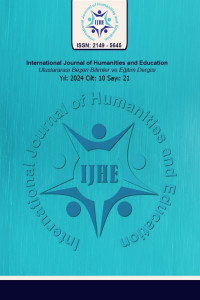Abstract
The Balkan Peninsula is an important region of linguistic diversity and mixture. For centuries, intensive and continuous linguistic contact and interlingual transfer has taken place here. The languages here are geographically located in the same region and are often found side by side in the same area. However, some of them are not genetically related, but show similarities in form and structure due to long-term contact. This region is of particular importance for understanding the mechanisms and consequences of language contact.
Gagauz Turkish, together with Turkish and Azerbaijani Turkish, forms the western branch of the Oghuz group of Turkish dialects. It is the closest written language to Türkiye Turkish. Due to its history and geography, it has considerable structural and syntactic convergences with the Balkan languages. As a result of contact with the Balkan languages, it has some features that differ from Türkiye Turkish. As far as structure is concerned, in Gagauz Turkish, the request sentences formed with non-finite verbs in Türkiye Turkish are formed by replacing the non-finite verbs with finite verbs that have received one of the suffixes imperative or request. There are also differences in syntax. While Türkiye Turkish has a structure that branches to the left, Gagauz Turkish has structures that branch to the right. Under the influence of the languages with which it interacts, Gagauz Turkish has developed a right-branching sentence structure based on finite verbs. These features are generally considered to be important indicators of contact-induced covergence.
This study provides information on language contact, the Balkan language union and the place of Turkish in this language union. The subjunctive sentence structure in Gagauz Turkish, which is the main subject of the study, is explained using examples from newspapers, novels, stories and fairy tales.
Keywords
Gagauz Turkish subjunctive subjunctive sentence right-branching structures language contact
Project Number
SDK-2022-11757
References
- Ana Sözü Gazetesi 30.06.2023. https://anasozu.com/wp-content/uploads/2023/05/Ana_Sozu_11_12.2023.pdf, adresinden 01.08.2023 tarihinde alınmıştır. Ana Sözü Gazetesi 22.12.2023. https://anasozu.com/wp-content/uploads/2023/11/Ana_Sozu_23_24.2023.pdf , adresinden 23.01.2024 tarihinde alınmıştır. Baboglu, N. (1969). Gagauz Folkloru (Latin Alfabesine akt. Svetlana Frangu, Redaktör Dr. Güllü Karanfil, İvanna Köksal, 2011). Komrat: M. Maruneviç adına Bilim Aaraştırmaları Merkezi Genel Üüretmek Müdürlüü.
Abstract
Balkan yarımadası, dil çeşitliliği ve karışımı gösteren önemli bir bölgedir. Burada, yüzyıllar boyunca yoğun ve sürekli dil teması ve diller arası aktarımlar gerçekleşmiştir. Buradaki diller, coğrafi olarak aynı bölgede yer almakta ve umumiyetle aynı topraklarda yan yana bulunmaktadır. Ancak bazıları genetik olarak akraba değildirler, yine de uzun süreli temas nedeniyle biçim ve yapı bakımından benzerlikler gösterirler. Bu bölge, dil temasının mekanizmalarını ve sonuçlarını anlamak için özel bir öneme sahiptir.
Gagavuz Türkçesi Türkiye Türkçesi ve Azerbaycan Türkçesi ile beraber, Oğuz grubu Türk lehçelerinin batı kolunu oluşturmaktadır. Türkiye Türkçesine en yakın yazılı dildir. Tarihi ve bulunduğu coğrafya itibarıyla Balkan dilleri ile önemli ölçüde yapı ve söz dizimi olarak yakınlaşma gösterir. Balkan dilleriyle temasının bir sonucu olarak da Türkiye Türkçesinden ayrılan bazı özelliklere sahiptir. Yapı bakımından Türkiye Türkçesinde bitimsiz fiillerle kurulan istek cümleleri Gagavuz Türkçesinde bitimsiz fiiller yerine emir veya istek eklerinden birini almış bitimli fiillerin getirilmesiyle yapılır. Ayrıca söz diziminde de farklılıklar vardır. Türkiye Türkçesinde sola dallanan bir yapı mevcutken Gagavuz Türkçesinde sağa dallanan yapılar mevcuttur. Gagavuz Türkçesi etkileşim içinde olduğu dillerin etkisiyle bitimli fiillere dayalı sağa dallanan bir cümle yapısı geliştirmiştir. Bu özellikler umumiyetle temas kaynaklı yakınlaşmanın önemli göstergeleri olarak kabul edilmektedir.
Bu çalışmada dil teması, Balkan dil birliği (Balkan Sprachbund) ve Türkçenin bu dil birliği içerisindeki yeri hakkında bilgi verilmiştir. Çalışmanın asıl konusunu oluşturan Gagavuz Türkçesinde istek bildiren cümle yapısı gazete, roman, hikâye ve masallardan örnekler verilerek açıklanmıştır.
Supporting Institution
Erciyes Üniversitesi Bilimsel Araştırma Projeleri Birimi
Project Number
SDK-2022-11757
References
- Ana Sözü Gazetesi 30.06.2023. https://anasozu.com/wp-content/uploads/2023/05/Ana_Sozu_11_12.2023.pdf, adresinden 01.08.2023 tarihinde alınmıştır. Ana Sözü Gazetesi 22.12.2023. https://anasozu.com/wp-content/uploads/2023/11/Ana_Sozu_23_24.2023.pdf , adresinden 23.01.2024 tarihinde alınmıştır. Baboglu, N. (1969). Gagauz Folkloru (Latin Alfabesine akt. Svetlana Frangu, Redaktör Dr. Güllü Karanfil, İvanna Köksal, 2011). Komrat: M. Maruneviç adına Bilim Aaraştırmaları Merkezi Genel Üüretmek Müdürlüü.
Details
| Primary Language | Turkish |
|---|---|
| Subjects | South-West (Oghuz) Turkic Dialects and Literatures, Linguistics (Other) |
| Journal Section | Research Article |
| Authors | |
| Project Number | SDK-2022-11757 |
| Publication Date | April 30, 2024 |
| Submission Date | March 27, 2024 |
| Acceptance Date | April 22, 2024 |
| Published in Issue | Year 2024 Volume: 10 Issue: 21 |
International Journal of Humanities and Education (IJHE)
This work is licensed under a Creative Commons Attribution-NonCommercial-No Derivatives 4.0 (CC BY-NC-ND 4.0) International License.


